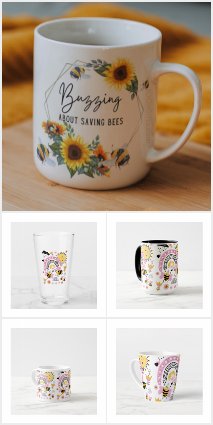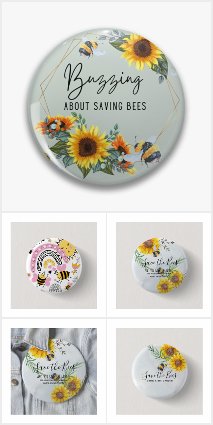How to make a Ground Bee Nest Box
Video comment from the The Bumble Bee Foundation Project
" ... Instead of digging a hole, make a mound. Very Important. If you look at how mice nest its always on an embankment. There is good reason for this. If it rains heavy a hole in ground will get flooded and all your bees will be lost. Inexperienced Rodents soon learn to nest in higher up ground. Do exactly what you did but just in a mound form and you will have great success. A bit like earthing up potatoes. Mice will also dig under a shed where its nice and dry. We have quite a few woodmice which are fantastic for making Bumble Bee Nest sites. also if you plant Thyme,Sage and Lemon Balm round your nest areas and Heather. The Heather flowers early and will attract early Queens, long before the the Honey Bees come out. The Thyme and Sage makes it harder for wax moths to find the nests. Wax moths destroy Bumble Bee Nests. "
Video comment by Ulla Stavnsbjerg
" ... I have just made a bumble bee nest box and the experts helping us brought some shredded paper collected in mouse cages at the animal stables of the medical school. That paper is smelling from mouse urine and should lure the bees to nest in the box."
Everything You Need To Know About Siting and Building A Bumble Bee Nest Box
paraphrased from source
Commercial bumblebee nest boxes are expensive, and they have a low success rate, resulting in a lot of disappointment. But don't lose heart because even expert scientists have a low success rate when it comes to bumblebee nest box occupancy - sometimes fewer than 10% of the boxes will be occupied - so don't give up hope. So, how can you increase your chances of success? To begin, there are a few fundamentals to consider.Check to see if you have the right size nest box for the bumblebees in your yard. To properly store your Bombus terrestris, lucorum, pascuorum, or lapidarius, you'll need a box the size of a tissue box or even a tiny shoe box in your collection. Other bumblebee species build much smaller nests that can be as small as a coffee can or as large as a tennis ball. So the first step is to inspect your yard to see if any bumblebee species are present. Refer to the resource link provided below for a simple reference to the most common species to determine which type of bumblebee you have. Even if you can't identify every species in your yard, you can protect them by providing two different sizes of nest boxes.
Place the nest box in the most appropriate location for the species. All species prefer to be protected from the north wind, though a full south position in the sun can be too hot for aboveground nesters.
Boxes that are larger in size. The majority of commercially available nest boxes are designed for species with larger nests, but images of them placed above ground can be found. This is misleading because most bumblebees prefer to nest underground or on the ground rather than in trees. Depending on its size, you must decide whether to bury or place a large type of nest box on the ground. This isn't much help if you have one of the more expensive boxes with a top that allows you to see into the bumblebees' nest. But it's not all doom and gloom. There are several methods for tricking bumblebees into thinking they are nesting underground when they are not. Simply attach a hose to the entrance, and the queen will believe she is entering a tunnel if the hose is black and the box is strategically placed. It's that easy!
Furthermore, because an abandoned rat nest at the end of a tunnel is a popular nesting site for this species, you are providing an ideal nesting site. If you don't have an observation nest, a nest box under the garden shed, partially or completely on the surface, would be the next best option. If you don't have an observation nest, it's still a good idea to attach a piece of garden hose to the entrance so the queen thinks she's entering a tunnel. Bury or partially bury it under a slate or pavement slab, decking, or steps, among other things. No matter where you put it, it should be protected from the elements.
Boxes that are smaller in size. Bumblebees with smaller nests are more likely to be found above ground.
It is much easier for these birds to find a suitable nesting location in a garden. For example, a bird box may already be in your possession without your knowledge. Typically, the box has not been cleaned out from the previous year, and the bird nesting material left behind is ideal for bumblebees to use as a home.
Another great location is a dry stone wall. You can replace one of the stones with a bumblebee box, a coffee can with a hole cut out of the plastic pop-off cap, or even a tennis ball. In the hopes of attracting bumblebees, I pushed a tennis ball through a hole cut out in the bottom of an old wall, but instead I attracted a wren. I'm not going to remove the nest in case a bumblebee queen decides to build a nest there next year. Make sure to cover the box's entrance, just as you would with larger ones.
Building material for a nest. Commercially supplied boxes usually come with nest material, which is usually fine, and even if the box hasn't been used, if the nest material is still dry, it's perfectly fine to leave it for another year. The best possible nest material for underground nesters is simply the dry contents of a mouse or vole nest, complete with droppings. Given that this is not always easy to obtain or acceptable to use, you can substitute dry grass clippings, dried moss, an old bird nest, or even old horsehair stuffing from a discarded chair or sofa. The main thing to remember is that it must be completely dry.
Cotton wool or any other synthetic material should never be used because it will entangle the bees. It is a good idea to place a cushion of scrunched-up chicken wire on the base of the box before placing the nesting material on top of it to keep the nest dry and allow debris to fall to the bottom. This allows debris to fall to the nest's bottom and helps keep it clean.
When and where should the nest box be placed. It is preferable if the box is installed as soon as possible following the event. Even if you have a sturdy box, it is a good idea to put it out now and test it to see if it will withstand the elements during the winter. Bumblebee queens appear to dislike "fresh" boxes, so leaving them outside for at least a few weeks is a good idea. Consider yourself fortunate if your prized bumblebee box becomes the home of mice or voles, and do not remove the contents until the problem is resolved. Nothing makes a bumblebee queen happier in a desirable habitat than the presence of a previous rodent inhabitant!

Send us a message if you have a bee-saving tale, anecdote, bee craft project, bee keeping tip, bee meme, bee tattoo, or anything else bee-related to share.

 3 ways you can help rescue bees
3 ways you can help rescue bees
Bees pollinate one-third of the food that we consume; without them, we would be extinct. You may contribute to the cause by taking these three simple actions.
1. Create a Bee Garden using plants that are beneficial to bees.
2. Fill a small dish halfway with clean water and set it aside as a Bee drinking bath. Make a swarming area with pebbles and stones for the bees to land on and drink from.
Visit my Bee Store for Bee awareness buttons, stickers, keychains and personalized gifts, accessories and decor.
This collection of adorable Save the Bee gifts, decorative items, and accessories has me buzzing with excitement. Text template fields allow you to include your own save the bees slogan, quote, amusing, friendly, or awareness-raising statement in addition to the default text template. What could be a better way to start your day than this? All of the items in the SaveBees store are decorated with adorable BEE drawings.
Bee enthusiasts, beekeepers, bee rescues, and bee fanatics will find something to their liking in this section. We must raise awareness about rescuing bees, protecting bees' habitat, planting bee-friendly flowers, allowing flowering weeds to develop, and providing bee resting locations, water, and room for all bees to thrive and establish hives. Join us!
The efforts of a slew of fantastic bee-friendly individuals have been spreading awareness, from the flightless bee with no foot to the courageous bee lady who saves and relocates bees while wearing no protective clothing!
She is very remarkable. You have the ability to BE wonderful as well. Find a BEE saving club to get bee photographs, photos, illustrations, and, most importantly, advice on how to protect and save bees and their colonies. Bumblebees, honey bees, and all other types of bees will thank you for getting it right this time. Spread the word about your love for bees far and wide. BEE lovers, have a wonderful BEE day.










